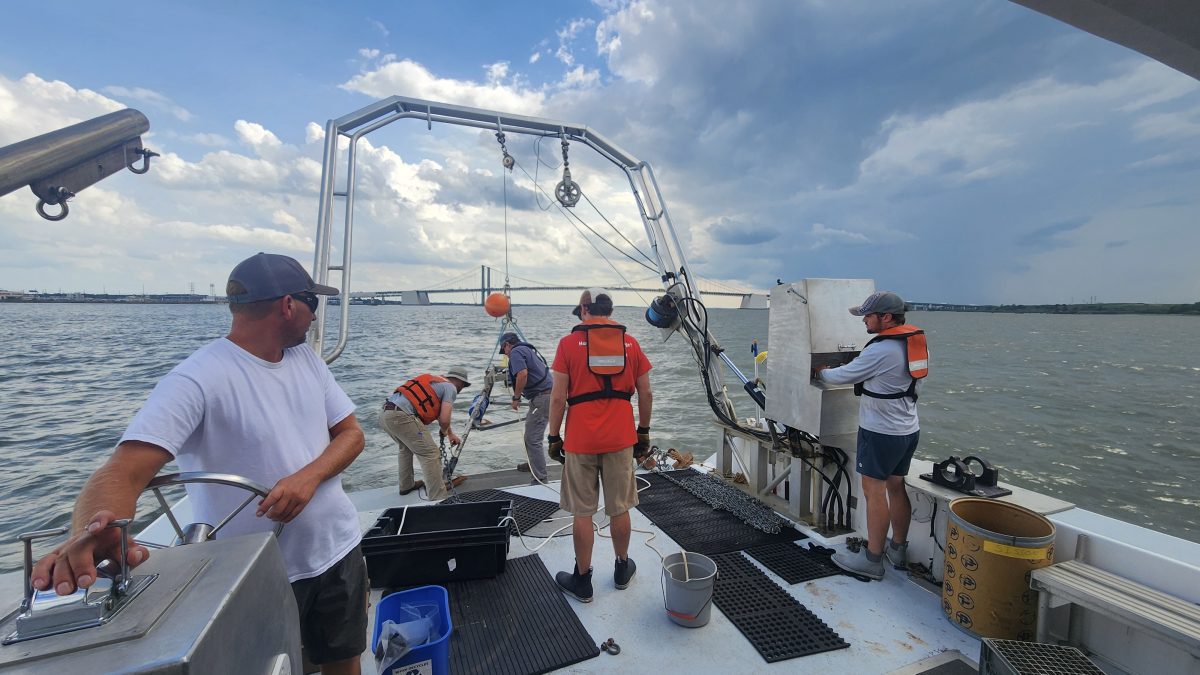New paper reveals global threat of salt contamination to water supplies in tidal rivers, threatening critical infrastructure
 Researchers deploy a sensor-laden tripod to measure currents and salinity in the Delaware River. The effort, set against the backdrop of the Delaware Memorial Bridge, is part of an NSF-funded study on estuarine transport in collaboration with Rutgers and the University of Delaware. (Photo by Dave Ralston, ©Woods Hole Oceanographic Institution)
Researchers deploy a sensor-laden tripod to measure currents and salinity in the Delaware River. The effort, set against the backdrop of the Delaware Memorial Bridge, is part of an NSF-funded study on estuarine transport in collaboration with Rutgers and the University of Delaware. (Photo by Dave Ralston, ©Woods Hole Oceanographic Institution) July 29, 2025
Researchers make urgent call for convergent interdisciplinary research to combat worsening crisis
Woods Hole, Mass. (July 29, 2025) – A new paper published in Environmental Science & Technology Letters warns of an emerging global threat posed by salt contamination of water supplies in tidal rivers worldwide. The paper, co-authored by David Ralston, Department Chair in the Applied Ocean Physics & Engineering Department in the Woods Hole Oceanographic Institution, along with an international team of partner institutions, highlights how a combination of climate change impacts—including prolonged drought and rapid sea-level rise—along with localized human activities, are intensifying the increase in salt in vital freshwater sources.
“This subject is a great example of how basic research on ocean and watershed processes affecting the salinity in estuaries and tidal rivers can help us manage the public health and economic risks from changing environmental conditions,” said Ralston.
Nationally, over $1 trillion in infrastructure investments are needed in drinking and wastewater systems, and in the Mid-Atlantic alone, nearly $100 million in agricultural activity is at risk. Beyond agricultural irrigation, salt contamination poses a substantial threat to industrial production and critical infrastructure through corrosion, compromising power plant cooling systems, water treatment plants, bridges, and other vital components.
Surface waters, including tidal rivers, provide approximately two-thirds of the global drinking water supply, and tidal rivers are increasingly vulnerable to saltwater intrusion. The paper synthesizes studies from around the world, detailing instances where drinking water intakes have been threatened in major rivers such as the Mississippi, the Delaware, and the Hudson in the United States, as well as global examples including the Changjiang in China, the Chao Phraya in Thailand, and the Rhine in Europe, among many others.
"Salt contamination of water supplies in tidal rivers is a global problem but has received little attention beyond site-specific studies," Dr. Li said. The research highlights oceanic and hydrological processes that drive saltwater intrusion, as well as watershed processes that lead to enhanced chemical weathering and the export of salts into rivers.
In the United States, there isn’t a federal drinking water standard for salinity. This critical research underscores the urgent need to bring together scientists, engineers, water resource managers, and lawmakers to protect freshwater supplies and the vital infrastructure that delivers them from the escalating threat of salt contamination. Recommendations include:
- Ion-Specific Measurements: Enhanced monitoring and measurement of major salt ions are crucial to better understand their sources, transport, and fate in watersheds and tidal rivers, aiding in the protection of infrastructure.
- Ion-Specific Hydrological-Hydrodynamic Models: Developing models that can simulate the transport of individual salt ions is essential for accurate prediction and for assessing risks to infrastructure.
- Human-Centered Decision Support Tools: The development of decision support tools for predicting and managing salt contamination should involve stakeholders through a human-centered design approach, ensuring that infrastructure resilience is a key consideration.
About the Authors:
The paper was authored by a comprehensive list of researchers from institutions including the University of Maryland Center for Environmental Science, the University of Maryland, the Pennsylvania State University, Rutgers University, the Woods Hole Oceanographic Institution, the Leibniz Institute for Baltic Sea Research Warnemünde, the University of Pennsylvania, and Salisbury University.
The paper is available at: https://pubs.acs.org/doi/10.1021/acs.estlett.5c00505
Funding for this project was provided by the National Science Foundation.
###
About Woods Hole Oceanographic Institution
Woods Hole Oceanographic Institution (WHOI) is a private, non-profit organization on Cape Cod, Massachusetts, dedicated to marine research, engineering, and higher education. Established in 1930, its mission is to understand the ocean and its interactions with the Earth as a whole, and to communicate an understanding of the ocean’s role in the changing global environment. WHOI’s pioneering discoveries stem from an ideal combination of science and engineering—one that has made it one of the most trusted and technically advanced leaders in fundamental and applied ocean research and exploration anywhere. WHOI is known for its multidisciplinary approach, superior ship operations, and unparalleled deep-sea robotics capabilities. We play a leading role in ocean observation and operate the most extensive suite of ocean data-gathering platforms in the world. Top scientists, engineers, and students collaborate on more than 800 concurrent projects worldwide—both above and below the waves—pushing the boundaries of knowledge to inform people and policies for a healthier planet. Learn more at whoi.edu.
Key Takeaways
- Climate Change as a Major Driver: Accelerated relative sea-level rise, altered drought and river flow, and extreme weather events are significantly increasing saltwater intrusion.
- Human Impacts: Local human activities, such as channel deepening in estuaries, excessive use of salt on roadways, and other human-accelerated chemical weathering in watersheds, have historically contributed to and continue to exacerbate salinity issues.
- Widespread Impact: Saltwater intrusion is affecting rivers across all continents, impacting diverse regions from semi-arid climates to precipitation-rich temperate zones, and causing damage to infrastructure.
- Broader Consequences: Freshwater salinization can lead to secondary effects, including the exacerbation of hypoxia and the mobilization of contaminants such as nutrients, metals, and radionuclides, which further stress water systems and their associated infrastructure.
